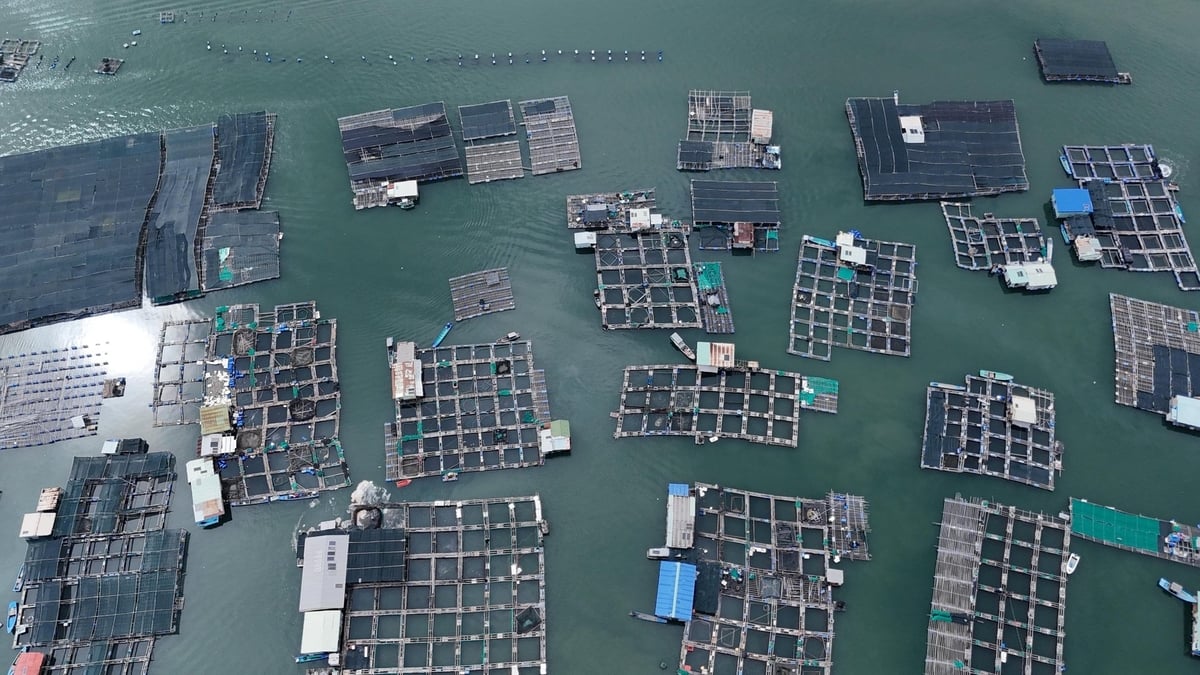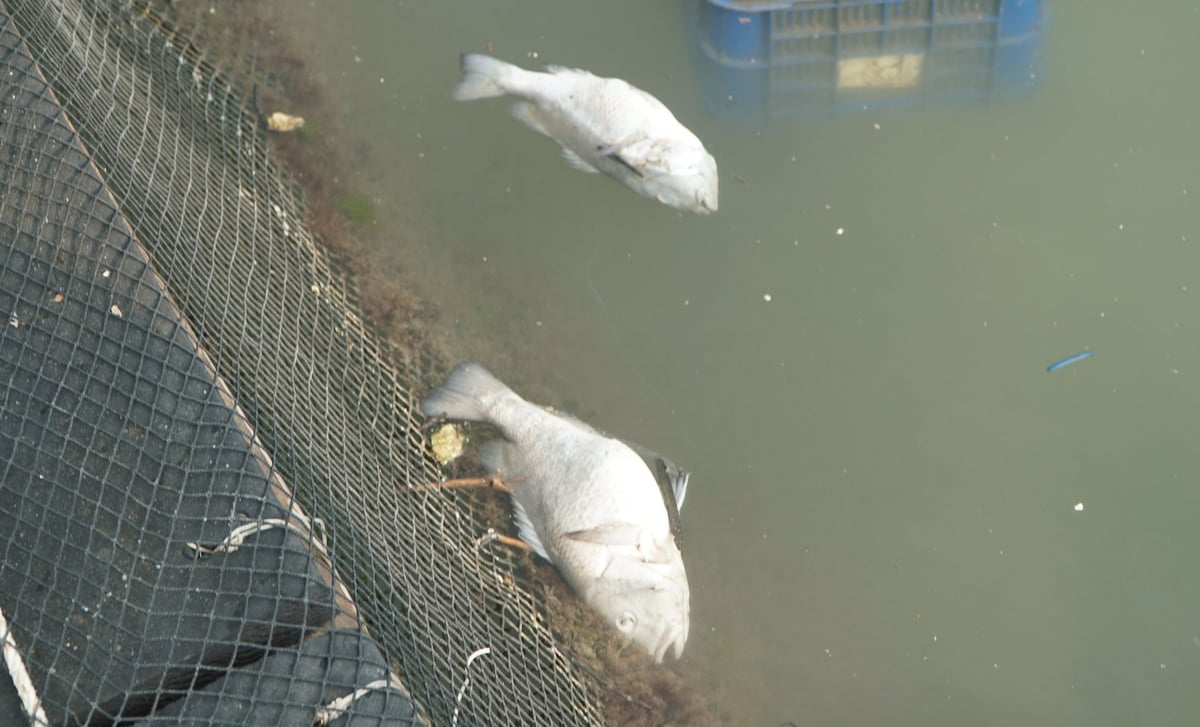October 9, 2025 | 03:46 GMT +7
October 9, 2025 | 03:46 GMT +7
Hotline: 0913.378.918
October 9, 2025 | 03:46 GMT +7
Hotline: 0913.378.918
Long Son commune (Ho Chi Minh city) has long been famous for its cage fish farming model on the Cha Va and Rang rivers. This is an area where aquaculture has developed strongly, thanks to its geographical advantage and abundant natural water resources, creating favorable conditions for high-value marine fish species such as cobia, butterfish, grouper, barramundi, etc. This model not only brings a stable source of income but also contributes to creating jobs for many households in the area.
However, the fish cage farming industry in Long Son is facing many challenges, particularly the mass fish deaths caused by water pollution and disease. In recent years, unusual fish deaths have caused billions of Vietnamese dong in losses for local people.

The Cha Va and Rang river areas in Long Son commune have thousands of cages for raising marine fish, bringing high economic value. Photo: Le Binh.
“During the transition of seasons, we farmers also have to pay special attention to the cages. Like last winter, the weather suddenly turned cold, the temperature dropped sharply between day and night, causing many farmed fish and oysters to die from temperature shock,” said Le Thi Thu Cuc, a fish farmer in Long Son commune.
Cuc has 30 cages raising various types of fish, but more than half of them have died. The remaining fish in the cages that survived experience slow growth. In normal circumstances, farming a batch only takes 8 months, and the fish would reach a weight of 800 g per fish, ready to be sold, but now it would take 10 months, or even 12 months. The production cost has therefore also increased by more than 20%. After last year’s final fish crop, Cuc lost more than VND 300 million.
From the view of fish cage farmer Nguyen Van Tung, the Cha Va and Rang rivers are affected by waste discharge activities from nearby production facilities and industrial parks, causing water quality to decline, creating conditions for bacteria and parasites to thrive.
“Fish farming depends entirely on water sources and weather, so sometimes fish farmers are very passive. We have no choice but to clean the cages thoroughly, not discharge waste indiscriminately, and add vitamins and minerals to increase the fish’s resistance,” he said.

Unstable weather conditions and water pollution put caged fish at risk of spreading disease and mass deaths. Photo: Le Binh.
“Common diseases in fish include viral hemorrhagic septicemia (VHS), epizootic ulcerative syndrome (EUS), water mold, Trichodina, and other diseases caused by Vibrio spp. bacteria or Benedenia spp. parasites. These diseases often break out when the water environment changes or the fish are stressed due to high stocking density. Season transitions or storms can cause environmental factors, such as temperature, salinity and dissolved oxygen in the water, to change, causing the fish to lose resistance and become susceptible to disease,” said Dr. Pham Quoc Huy, Director of the South Research Sub-institute of Marine Fisheries.
To prevent aquatic diseases, the Sub-Department of Fisheries and Fisheries Surveillance Region III (under Ho Chi Minh City Department of Agriculture and Environment) collects water samples for monthly monitoring and gives out warnings to the people about changes in the aquaculture environment. Thanks to constant efforts, the Sub-Department can have certain control over indicators that are outside the allowable limits while providing the people with guidance on disease prevention and control solutions, as well as farming orientation.

Fish farmers need to regularly clean cages and use aeration systems during the rainy season to help fish breathe easily and avoid mud on their gills. Photo: Le Binh.
According to Doan Van Nam, an expert from the Sub-Department of Fisheries and Fisheries Surveillance Region III, fish raised in cages grow in an open environment, so the disease treatment process is relatively difficult. Farmers must pay attention and follow the correct procedures from fish stock selection, the caring process, disease prevention and treatment. The fish must be of guaranteed quality, purchased from reputable seed producers, fully inspected and tested for diseases, and stocked at a lower density.
"Farmers can use medicine to treat viral diseases. As for parasitic diseases, the most effective solution is to bathe freshwater fish in saltwater and vice versa, and the parasites will leave. The second method is to hang bags of salt or lime in the feeding area and do a good job of treating the water before putting the fish in the pond,” he said.
Farmers should observe daily, record environmental changes through indicators such as temperature, pH, and dissolved oxygen to make timely adjustments, and prepare oxygen supply machines in case local oxygen deficiency occurs. It is also crucial to closely monitor weather developments, flood levels on rivers, and storms by following newspapers, radio, and warnings from authorities for proactive responses.
Translated by Samuel Pham

(VAN) The Ministry of Agriculture and Environment has requested Nghe An to expedite the disbursement of ERPA funds, avoid backlogs, ensure the rights of forest owners, and promote sustainable forest development.

(VAN) Operating a European-standard refrigeration system at full force, Thanh Bao Han poultry slaughterhouse ensures tens of thousands of safe meals every day.

(VAN) Large timber is the foundation for elevating the wood processing and export industry, and community-based agricultural extension acts as the forestry sector's 'extended arm'.

(VAN) An Giang is capitalizing on its maritime advantages: high-tech aquaculture, marine tourism, and renewable energy, which are becoming pillars of the marine economic development.

(VAN) From household groups to cooperatives practicing sustainable forest management, local communities are contributing to the expansion of forest certification, helping Vietnam's wood industry overcome international market barriers.

(VAN) Thanks to his know-how in disease prevention for softshell turtles, a farmer in Can Tho has achieved a production success rate of over 80%.

(VAN) Poultry farming is evolving fast. Between labour shortages, rising production targets and growing demands for animal welfare, managing a poultry farm is more complex than ever.